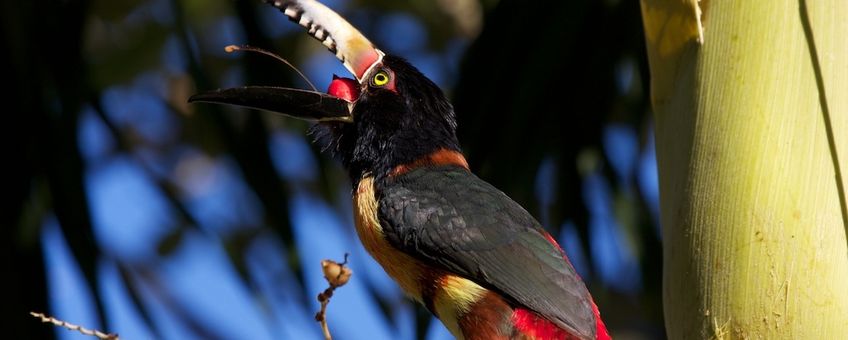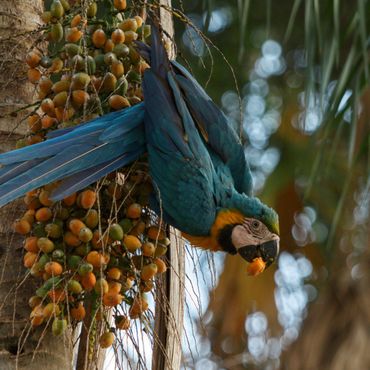
Open wide! What bird beaks say about tropical biodiversity
Institute for Biodiversity and Ecosystem Dynamics (IBED)The biodiversity in tropical forests is enormous. But how did it come into being? In view of the large-scale destruction of such forests, this is a pressing question in ecological research. An international team led by the Swiss Federal Institute for Forest, Snow and Landscape Research WSL has now explored how interactions between birds and palms may have increased biodiversity.
Fruit-eating birds
Most palm species produce fleshy fruits that are eaten by birds and mammals, which afterwards spread the seeds. Birds often swallow fruits whole, and thus the width of their beaks limit the size of fruits they can consume. ‘In my research group, we have studied for many years this fascinating interaction between fruit characteristics, such as size and colour, and the animals that consume them,’ says Dr. W. Daniel Kissling from the UvA Institute for Biodiversity and Ecosystem Dynamics, who has co-authored the study. ‘Fruits of palms are particularly interesting because they are an important food source for tropical animals, being eaten not only by birds and mammals but also by reptiles, beetles, crabs and fishes,' explains Kissling.
The researchers created the first global map that connects the beak opening or gape widths of birds and the size of palm fruits. ‘Typically, species interactions are studied locally or regionally - we looked at this on a global scale using measures of bird beaks and palm fruit sizes,’ explains Dr. Ian McFadden from the WSL, who is first author of the study.
Datasets
Two recently-published datasets made this study possible: the AVONET database, which contains trait measurements for nearly all bird species worldwide, and PalmTraits, a comprehensive trait database for palm species, which has been established by Kissling and his colleagues. For the analysis, 1100 fruit-eating bird species and 2000 fruiting palm species were added. By using statistical path models, the researchers assessed how the relationship between beak widths and fruit sizes was affected by factors such as climate, plant biomass production, species richness and Earth’s tectonic history.
Stronger matching near the equator

It turned out that the closer the species lived to the equator, the more closely bird and fruit traits were matched. This pattern was strongest for Africa, but weaker on islands such as Madagascar. On that island there are fewer fruit-eating birds but many lemurs that eat fruits, which may weaken the bird-palm matching pattern there.
The tighter coupling between bird beaks and palm fruits near the equator was found all over the world, although actual beak and fruit sizes differed between continents. Bird and palm trait sizes were overall largest in Southeast Asia, smallest in the Southeastern US and medium-sized in South America and Africa. In the model, climate did not directly influence how strongly beaks and fruits were correlated but did have indirect effects via palm diversity, which is higher in warmer tropical regions.
Studying the interconnectedness of trees and seed dispersers is also one way to guide practical nature conservation. ‘If you want to restore degraded forests, you also have to take seed-dispersing animals into account and, if necessary, reintroduce them,’ McFadden says. After all, the majority of fruits in the tropics are dispersed by animals.
According to the researchers, the study provides support for the hypothesis that the tropics have such high biodiversity partly because species interactions are stronger there. This finding increases our basic understanding of tropical forests and can help to find optimal leverage points for their protection. However, Kissling adds: ‘We still have little information about the actual outcome of the fruit consumption by animals, for instance how far seeds are dispersed, how viable seeds are after gut passage, and how many seeds are actually deposited on sites that match the germination and/or establishment requirements of those plants.’
More information
You can find the full publication here.
Text: IBED
Photos: Christofer Silva Oliveira; John Norton
